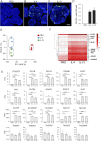Generation and functional characterization of tuft cells in non-human primate pancreatic ducts through organoid culture systems
- PMID: 40395933
- PMCID: PMC12089129
- DOI: 10.3389/fcell.2025.1593226
Generation and functional characterization of tuft cells in non-human primate pancreatic ducts through organoid culture systems
Abstract
The pancreatic duct plays a key role in collecting pancreatic juice, which is rich in digestive enzymes. The fluid flows unidirectionally into the duodenum, where it mixes with partially digested food to further facilitate digestion. In this study, we report the generation of pancreatic ductal organoids from non-human primates for the first time, aimed at investigating the role of tuft cells that reside in the pancreatic duct since no studies have addressed the role of tuft cells in the pancreas. The organoids were maintained in a medium supplemented with Wnt3a, Noggin, R-spondin, and other factors that support pancreatic duct proliferation. These pancreatic organoids expressed the stem cell marker LGR5 mRNA and the ductal marker protein CK19, although tuft cell markers were not detectable at this stage. Upon stimulation with IL-4/13, tuft cell differentiation was confirmed by immunohistochemistry and transcriptomic analysis. We observed induction of DCLK1, as well as taste signaling molecules such as TRPM5 and PLCβ2, which are markers of type II taste cells. Additionally, upregulation of LYZ and DEFB1 mRNA indicated the expression of antimicrobial peptide markers, alongside molecules associated with inflammation. Furthermore, the differentiated organoids specifically responded to a bitter compound, suggesting that pancreatic tuft cells may play a role in detecting potentially harmful chemicals. Finally, immunohistochemical analysis identified tuft cells in the non-human primate pancreas, supporting their involvement in sensing harmful compounds and regulating protective responses within the pancreas.
Keywords: organoid; pancreas; primate; tuft cells; type 2 immunity.
Copyright © 2025 Sakaguchi, Kimura-Nakajima, Inaba, Hatano, Ogawa, Koshiishi, Tanaka, Kometani, Ohmoto, Sato, Imai and Iwatsuki.
Conflict of interest statement
The authors declare that the research was conducted in the absence of any commercial or financial relationships that could be construed as a potential conflict of interest.
Figures






Similar articles
-
Identification and manipulation of biliary metaplasia in pancreatic tumors.Gastroenterology. 2014 Jan;146(1):233-44.e5. doi: 10.1053/j.gastro.2013.08.053. Epub 2013 Aug 30. Gastroenterology. 2014. PMID: 23999170 Free PMC article.
-
Interleukin-4 Promotes Tuft Cell Differentiation and Acetylcholine Production in Intestinal Organoids of Non-Human Primate.Int J Mol Sci. 2021 Jul 24;22(15):7921. doi: 10.3390/ijms22157921. Int J Mol Sci. 2021. PMID: 34360687 Free PMC article.
-
Study on Lgr5 expression in pancreas tissues and organoids by lineage tracing.Yi Chuan. 2022 May 20;44(5):432-441. doi: 10.16288/j.yczz.22-022. Yi Chuan. 2022. PMID: 35729700
-
Advances in tuft cells, a chemosensory cell in sequential diseases of the pancreas.Biochim Biophys Acta Rev Cancer. 2023 Jul;1878(4):188911. doi: 10.1016/j.bbcan.2023.188911. Epub 2023 May 12. Biochim Biophys Acta Rev Cancer. 2023. PMID: 37182665 Review.
-
The Potential of Pancreatic Organoids for Diabetes Research and Therapy.Islets. 2021 Sep 3;13(5-6):85-105. doi: 10.1080/19382014.2021.1941555. Epub 2021 Sep 15. Islets. 2021. PMID: 34523383 Free PMC article. Review.
References
LinkOut - more resources
Full Text Sources

